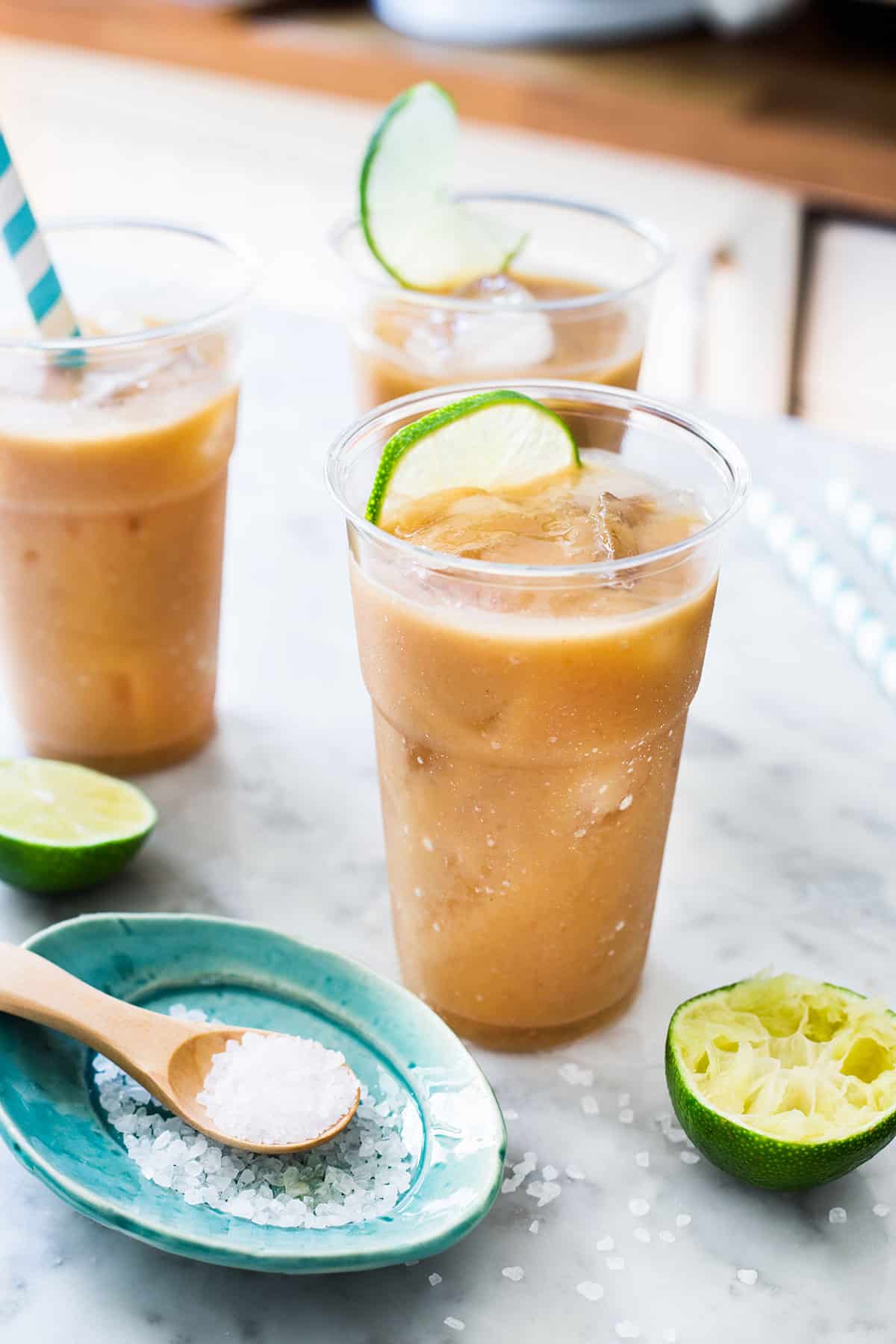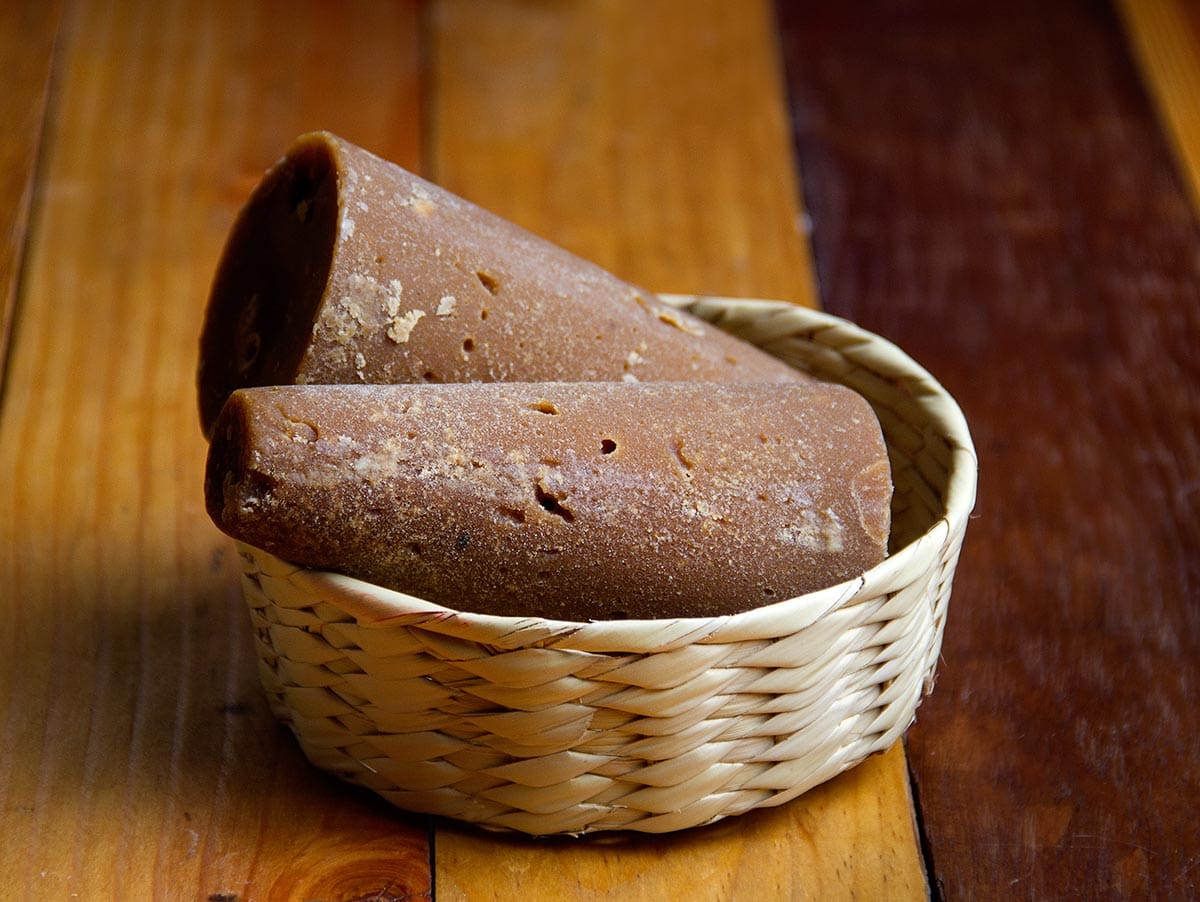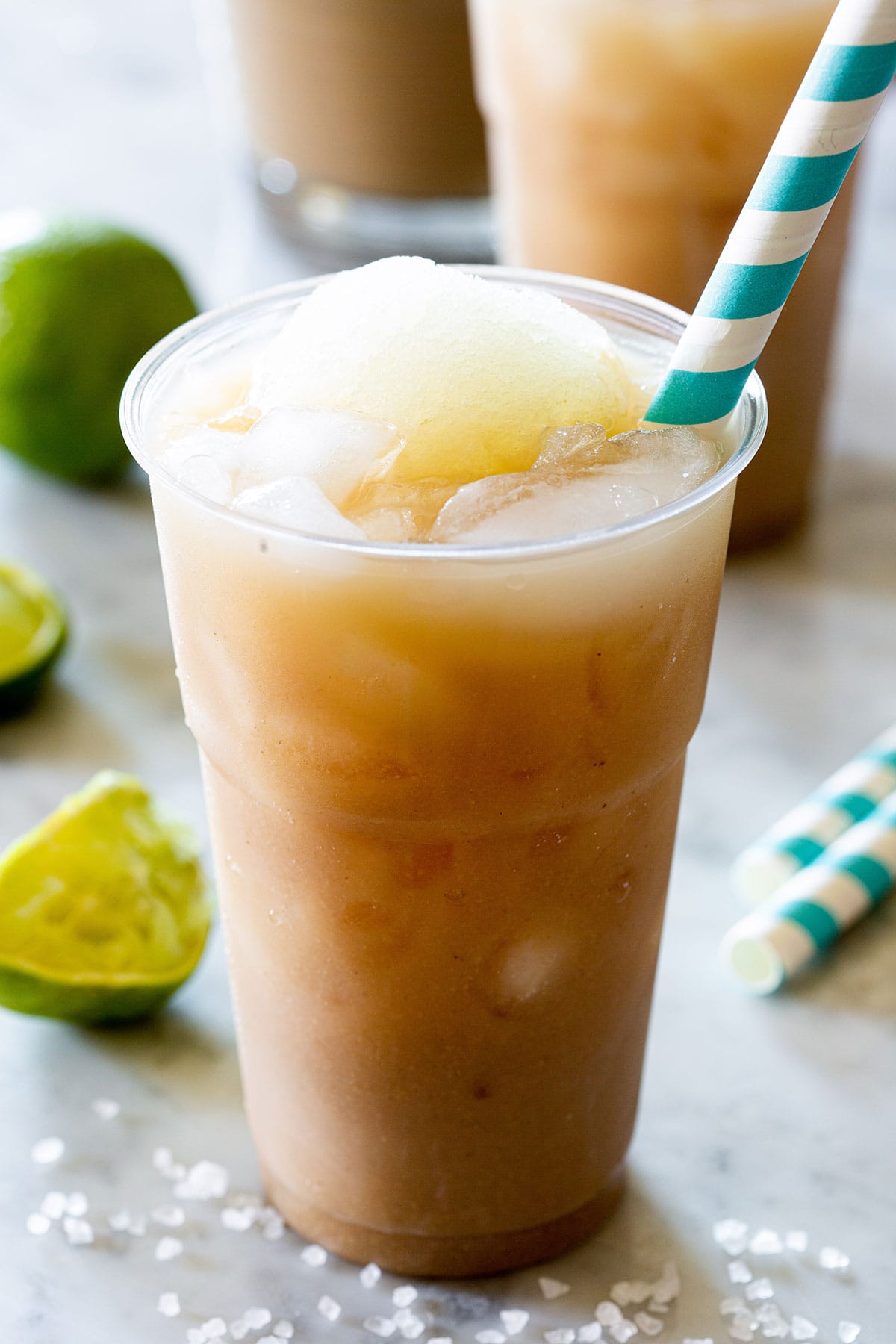Traditional tejuino is a Mexican drink recipe with ancient origins. Made with corn masa, piloncillo, and water, this fermented beverage is also naturally gluten-free. Enjoy with crushed ice, lime juice, and a pinch of salt.
I am from Colima and this beverage for me brings so many memories, like drinking it mostly during the hottest summer days or on my way back home after school.
What Is Tejuino?
Tejuino is a traditional Mexican cold beverage made from fermented corn masa, piloncillo, and water.
The drink is widespread in the states of Colima, Jalisco, and Nayarit and is also known by other names such as tecuino or tesgüino.
Tejuino has a sweet, sour, smoky, tart, and salty taste. This interesting and particular tasting profile comes from the fermented corn masa, unrefined cane sugar (piloncillo), lime juice, and salt.
Up to the present time, this drink is found mostly as street food in Mexico where you’ll see carts selling and preparing this drink on the go.
The street vendors are called tejuineros and many of them have been doing this for generations.

Their way of making this ancient beverage try to honor the traditional recipe so is made as authentic as possible, that is, fermenting the preparation in a large clay pot.
Once the drinks have the right consistency and taste, usually after 3-4 days, the mixture will be diluted by adding more water.
It’s believed that tejuineros don’t wash the clay pots where tejuino has been made, so the scraps of the preparations that remain stuck to the pot help with the next fermentation.

Watching a tejuinero serve this beverage is such an authentic experience. You will see how fast he will mix the drink back and forth between cups to combine.
The History
In Mexico, since pre-Hispanic times, fermented foods and beverages have been a daily and ceremonial custom in various communities.
So, is believed that the origin of this refreshing drink dates back nearly seven thousand years, as some traces have been found in archaeological zones of Jalisco.
Being a pre-hispanic beverage, it was mainly made and consumed by the Nahua people. The ancient Mexicans called the corn teocinte, a Nahuatl term that means “food of the gods”.
Some experts declare that the word Tejuino is of Nahuatl origin and means “beat” or “to beat the heart”, referring to the effect fermented beverages have on heart rate.

To the previous description, tejuino has been always considered the “drink of the gods”.
What is made of?
Tejuino is made of corn dough (masa), piloncillo, and lime juice. Let’s take a look at the two most important ingredients…
CORN MASA: Masa is a staple in Mexican gastronomy, and it refers to the dough created with dried white corn processed with an alkaline solution. This process is called Nixtamalization.
With Nixtamalized corn masa, other traditional recipes can be created, such as tortillas, sopes, tamales, or tlacoyos.
Corn masa has a high fiber and calcium content, besides being naturally gluten-free. When fermented, corn masa provides a sour taste and the classic corn flavor to this beverage.
- How to make masa: You can make corn masa by combining masa harina (nixtamalized corn flour) and water.
- Where to buy masa harina: Masa is widely carried by Amazon and Latino American online stores, but also can be found in international aisles in some local supermarkets. Or, if you have a tortilla shop near to you, you can buy masa from there too.

PILONCILLO: Another staple in traditional Mexican cooking, this ingredient is the rawest form of cane sugar made by boiling down cane juice into a thick syrup. It comes in various shapes and shades, the most popular is the pilons (pylons) which it takes its name from.
Other traditional Mexican drinks that include piloncillo are café de olla and champurrado. Piloncillo not only adds the sweet but also a particularly smoky taste.
- Taste: Think a bit of molasses, but with some burnt caramel notes and a smoky touch.
- Other names: Piloncillo has so many other names, even in Mexico. So, if you want to find it, try also other names such as panela, panocha, rapadura, raspadura de guarapo, pepas dulces, atado de dulce, papelón, raspadura, tapa de dulce, empanizao, chancaca. In some countries in Asia you can also find it as jaggery or gur.
- Where to buy: Same as masa harina, try first in online stores such as Amazon or in your local supermarket.

Health Benefits
The wixárikas people think this drink can reduce gastrointestinal disorders and counteract the effects of alcohol.
But, if you have tried (or heard) before drinks like Kombucha or Tepache, you might know by now how healthy fermented beverages are made.
Depending on what bacteria and yeast were used to culture a specific fermented drink, they will offer slightly different benefits.
But, overall, lightly fermented drinks are a powerful source of beneficial bacteria that helps to support your digestive system health.
Fermented drinks often contain vegetables, fruits, and herbs which can add some extra micronutrients and probiotics to the beverage.

The presence of probiotic bacteria in fermented drinks makes tejuino a beneficial drink since probiotics improve metabolism, and the functioning of the digestive system, fight and prevent intestinal diseases, increase the absorption of nutrients and nourish the intestinal flora, among others.
Ingredients Needed
- MASA HARINA: From nixtamalized corn flour.
- PILONCILLO: To sweeten the beverage. If you can’t find piloncillo where you live, try with molasses.
- WATER: Some people affirm tap water can possibly inhibit fermentation, so you might want to use purified water.
- CRUSHED ICE: This help to dilute the mixture and give it a more drinkable texture.
- LIMES & SALT: Adds a nice salty-sour flavor that combines nicely with the sweetness and flavor of piloncillo.
- SORBET: This is totally optional, but if you have some lemon or lime sorbet available, try adding a scoop on top and you’ll see how delicious is!

Important Note: Colima is also famous for its production of the best limes in the whole country, and not only, but salt from Cuyutlán (a small coast town in this state) is also one of the highest quality you can find.
How To Make Tejuino
Place 2 ½ cups of water in a bowl or large container and add masa harina while whisking.
Mix well until there are no more lumps and a runny masa mixture is made.

In a medium pot, place another 2 ½ cups of water over medium heat and bring to a simmer.
Add piloncillo and reduce the heat to low. Break the piloncillo little by little with the help of a wooden spoon until is completely dissolved.
NOTE: If you using molasses add first a spoonful, dilute, taste, then add more until is sweet enough to your taste (you can add more later aswell).

Now, slowly and while mixing, add the masa harina mixture and keep stirring until all ingredients blend together.

Cook for about 15 minutes mixing constantly to prevent it from sticking to the bottom.

The tecuino will start to have the right consistency after 10 -15 minutes, so keep cooking (at low heat) until you’ll have a thick mixture that fully coats the back of a spoon.

Turn off and remove the pot from heat. Then, transfer the mixture to a glass, ceramic, or clay container.
Add lime juice and mix well. Allow cooling down while mixing from time to time, to prevent skin from forming on the surface.

Once the mixture is at room temperature, cover loosely with a towel or cheesecloth and place the container in a dark and cool place from 48 to 72 hours, undisturbed.
After that time, it will look like the photo below.

How To Know When Is Ready
The mixture should have a sticky and slimy consistency with some small bubbles on top.
It shouldn’t have any grey-green-ish spots because those are clear signs that tejuino has turned bad, so if that happens, throw it and start a new batch. The smell should be somehow sour but pleasant.
How To Serve
- Place 2 cups of crushed ice on a large pitcher. Add 1 ½ teaspoon of coarse salt, and the juice of 2 limes.
- Add 1 cup of the tejuino mixture and 1 cup of water.
- Mix the ingredients until combined, then adjust with lime and salt to taste.
- Serve in cups and add a scoop of lime sorbet on top if desired.

Single serving: Fill some large cups with crushed ice, then add the juice of half a lime and a pinch of salt.
Mix with a spoon or combine by pouring the drink from a cup into another 4-5 times. When ready serve in one cup with a straw.
Recipe Notes And Tips
- Add the masa mixture into the hot water slowly to prevent lumps from forming.
- Stir constantly to prevent the mixture from sticking to the bottom.
- Preparing tecuino in a large pitcher is easier than doing it in single cups, and is also perfect to serve at parties and gatherings.
- If you notice that the mixture is a bit coagulated, it’s normal, so don’t worry.
- Just as you do when preparing other fermented drinks, make sure your utensils are perfectly clean to prevent bad bacteria from forming.

Troubleshooting
- If the mixture spoils on the first day: Take in mind that temperature plays an important role when making fermented drinks. If it’s too high, your mixture risks going bad, that’s it if some green/greyish spots appear on the surface. So prevent that by placing the container in a cool place in your home.
- Spoiled mixture within 3 days: Light and oxygen also are important. You want your mixture to be covered just not so tight that could create too much humidity inside.
- Not fermented mixture: Once fermented, the concentrated tecuino mixture should taste a bit sour, so try a bit with a spoon, if you think is missing flavor, allow it to rest another half a day in a warm place, to accelerate the fermentation process.

Recipe Variations
- The most popular variation to the traditional recipe is serving it with a scoop of nieve de limón –lime sorbet, it really makes this drink even more refreshing.
- Modern recipes also include a pinch of chili powder or hot salsa like chamoy, which adds some delicious spiciness.
- And in some places, you can get a boozy version with some beer on it.
- The last time I was in Colima I had a version of this drink with tamarind, so delicious!
How To Store
- The tecuino mixture can be stored in a glass container for up to 4 days in the fridge.
- If you already mixed it with ice, lime, and salt but got some leftovers, better to drink it within 24 hours.
- You can also freeze the fermented mixture, even though I am not sure if the drink loses some of its nutrients when doing this. I have frozen mine for about 1 month and it was still delicious.
FAQ
Is this beverage alcoholic?
No, tejuino contains only a tiny amount of alcohol, similar to a kombucha drink.
What is the difference between tejuino and tepache?
Tejuino is made of corn, has a thick texture, and a different tasting profile than tepache, which is made of fermented pineapple and has a lighter texture and fruity taste.
Watch How To Make It
Did you know? In Mexico, you can find many other fermented drinks such as Colonche, Tepache, Pozol, Tuba, and Pulque, to name a few.

Tejuino
Ingredients
- 4 ½ cups water
- 1 ¼ cup masa harina
- 12 oz piloncillo (or brown sugar, molasses)
- 1 lime (juice)
For serving
- Limes
- Crushed ice
- Sea salt
Instructions
- Put half of the water into a bowl or container and add the dough, whisk until there are no lumps.
- Pour the other half of the water into a pot over high heat and bring to a boil. As soon as it starts to boil, add piloncillo or brown sugar and reduce the heat to low.
- Break into pieces the piloncillo with the help of a wooden spoon and mix until is completely dissolved (see notes).
- Add masa dough mixture slowly and mix until combined.
- Allow to gently simmer for 15 minutes while stirring constantly.
- Turn off the heat. Then, transfer the mixture to a glass, ceramic, or clay container.
- Add lime juice and mix well. Allow cooling down while mixing from time to time, to prevent thick skin from forming on the surface.
- Once tejuino is at room temperature cover and let it ferment undisturbed in a dark and cool place for 2-3 days (see notes).
Serve
- Place 2 cups of crushed ice on a large pitcher.
- Add 1 ½ teaspoon of coarse salt, and the juice of 2 limes.
- Add 1 cup of the tejuino mixture and 1 cup of water.
- Mix the ingredients until combined, then adjust with lime and salt to taste.
- Serve in cups and add a scoop of lemon sorbet on top if desired.
Notes
Nutrition Information
Did you enjoy this authentic Mexican recipe? Please, don’t forget to rate it and leave a comment below. Also, remember that you can share and follow this blog on PINTEREST, INSTAGRAM, FACEBOOK, and YOUTUBE.
Similar Recipes
- Agua de tamarindo. Tarty and sweet, this refreshing beverage is delicious.
- Raspados. Learn everything you need to know about Mexican shaved ice, plus an easy recipe to make them at home.
- Champurrado. An ancient Mexican drink perfect to enjoy hot in the morning.
- Cucumber agua fresca. This healthy and refreshing beverage can be paired with any of your favorite Mexican recipes.



Explain how this is Pre-hispanic if it uses an ingredient from sugar cane
I actually explained that in the post. You might want to take a look at.
Es fresco y deliciously! 😊 gracias
I love your recipe it’s it’s so thorough I actually tried it three or four times now and I don’t know what I’m doing wrong every time I for meant it it gets mold on top it’s in a cool dark place covered with a kitchen towel I even tried cheesecloth and I have it in a glass jar maybe you can help me out with this what am I doing wrong
Hi Regina, it gets mold since day one? Is your masa fresh? if you using masa flour, aka Maseca (as I do), sometimes, specially if it’s a bit old, may spoil your preparation.
Try placing the mixture in the refrigerator, in the less cold zone, and see how it goes. If it gets moldy again, definitely is because one of the ingredients (my bet is on the flour) is expired.
Naci en Jalisco, pero vivi la mayor parte en Colima, asi que el tejuino es para mi la bebida mas refrescante y deliciosa que se haya creado. A pesar de que donde vivo ahora no hace mucho calor, si aprendo a prepararla como lo hacia mi abuelo q.e.p.d. hasta en los dias mas frio de invierno la tomare :) muchas gracias Maricarmen por compartir ademas de la receta, tanta información. Excelente!
Que bueno que te gustó :) yo desde que aprendí a hacerlo no paso un verano sin mi tejuinito!
i love cooking food . seems delicious. thanks for the recipe .
Deliciosa receta,para hacer en estos calores californianos y la verdad a vemos mucha comunidad hispana que les va a encantar so ha preparar la receta.Gracias Mary! Por tan deliciosa receta.
I albsolute love how you explain the recipes so passionate and highly detailed. I also love your pictures so much haha, we have the same Pyrex measure cups, they are the best! About the recipe, was my first time even testing the tejuino so I don’t have much to compare but I did enjoy it and it was more easy than I though, so thank you very much!